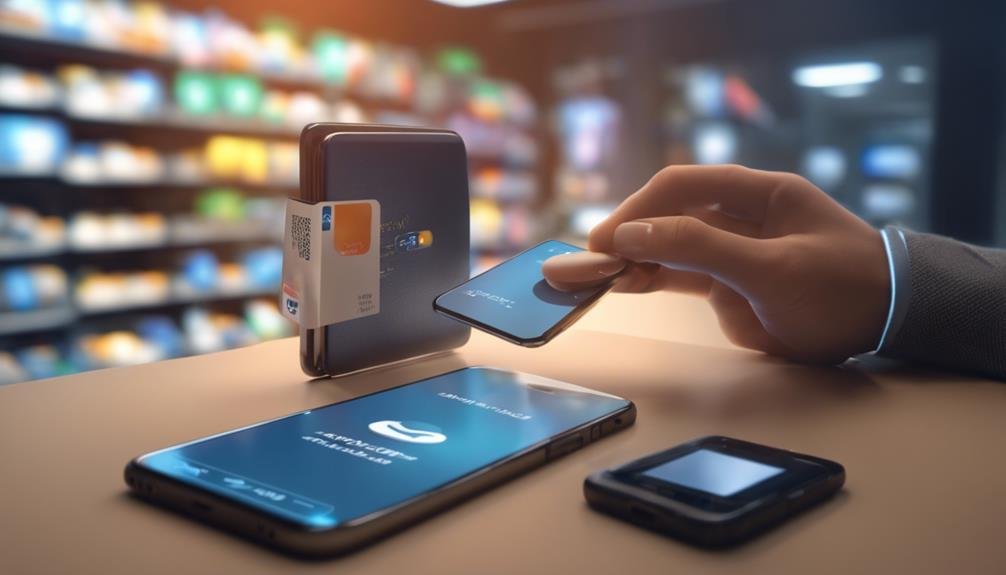Apple Pay: What It Is, How It Works, Growth
Apple Pay has emerged as a prominent player in the world of digital payments since its inception in 2014. With a solid foundation in secure NFC technology and a growing user base surpassing 441 million globally, its market share dominance in the U.S. is remarkable. The unique blend of robust security measures and strategic partnerships has propelled Apple Pay's evolution, making it a compelling option for modern consumers seeking convenience and safety in their financial transactions. As Apple Pay continues to expand its reach and enhance its features, the question of its future trajectory and potential innovations remains a point of interest for observers in the digital payment landscape.
Key Takeaways
- Apple Pay is a mobile payment system and digital wallet launched in 2014, facilitating secure transactions via NFC technology.
- Users can tap and pay at NFC-enabled terminals, generating unique transaction codes for each purchase.
- Apple Pay has seen significant growth, with close to 441 million global users in 2019 and holding 48% of the U.S. mobile wallet market in 2022.
- Security features like biometric authentication and tokenization make Apple Pay a preferred choice for safe and convenient digital payments.
- Apple Pay is expanding through partnerships with banks, enhancing accessibility, acceptance, and driving further adoption in the market.
Apple Pay Overview
How does Apple Pay revolutionize the landscape of digital transactions with its innovative mobile contact payment system and digital wallet service, creating a seamless and secure payment experience for users worldwide?
Apple Pay, launched in 2014, functions as a mobile payment system and digital wallet, allowing users to make transactions via near-field communication (NFC) technology. By storing payment information securely in Apple Wallet, users can swiftly complete purchases in-store or online using their supported devices such as iPhone, Apple Watch, iPad, and MacBook.
The platform enhances security by generating unique transaction codes and offering biometric authentication through Touch ID and Face ID. Apple Pay's integration with various payment systems and its emphasis on user convenience make it a prominent player in the world of mobile payments and digital wallets.
Functionality and Usage
Apple Pay's functionality and usage exemplify a seamless and secure payment experience, revolutionizing digital transactions through its innovative mobile contact payment system and digital wallet service. Users can tap and pay with NFC-enabled terminals or online, send money via messaging on iOS devices, and select cards on the app for transactions. It generates unique codes for each transaction, enhancing security and eliminating the need to share card details with merchants.
Apple Pay works with any contactless payment system, not limited to Apple-specific terminals, making it versatile for mobile transactions. Accepted widely at retailers and apps, it streamlines the payment process and provides a convenient and secure digital wallet solution for users.
Growth Statistics and Trends
Recent data analysis reveals a significant upward trajectory in the growth of Apple Pay usage and adoption, indicating a substantial shift towards mobile payment solutions in the market. User adoption of Apple Pay has been steadily increasing, particularly among young Americans, with close to 441 million global users reported in September 2019.
In August 2022, Apple Pay claimed 48% of the U.S. mobile wallet market, showcasing its dominance and appeal. The market trends suggest that making purchases with Apple Pay is not only secure but also convenient, contributing to its continued growth and market share expansion. Partnerships with banks and ongoing development of features further solidify Apple Pay's position in the mobile payment landscape.
Security and Convenience Features
The integration of advanced security measures and streamlined convenience features sets Apple Pay apart in the competitive landscape of digital payment solutions.
Apple Pay incorporates biometric authentication methods like Touch ID and Face ID, providing an extra layer of security by requiring unique user verification for each transaction.
Additionally, Apple Pay utilizes tokenization technology, replacing sensitive card information with a randomized token, reducing the risk of data breaches during transactions.
This technology generates unique transaction codes, ensuring that actual card details are not shared with merchants, enhancing overall security.
These security features, coupled with the ease of use and widespread acceptance, contribute to making Apple Pay a preferred choice for consumers looking for secure and convenient digital payment solutions.
Market Expansion and Partnerships
Amid the evolving landscape of digital payment solutions, the strategic market expansion and partnerships of Apple Pay are pivotal for its sustained growth and penetration.
Apple Pay has been actively focusing on market penetration by forming strategic alliances with banks and financial institutions. These partnerships have enhanced the accessibility and acceptance of Apple Pay among consumers, contributing to its increasing market share.
By collaborating with key players in the financial industry, Apple Pay continues to expand its reach and services, making it a preferred choice for users seeking secure and convenient payment options.
The emphasis on strategic partnerships underscores Apple Pay's commitment to strengthening its position in the market and driving further adoption among consumers.
Benefits and Future Prospects
In light of its strategic market expansion and partnerships, Apple Pay's benefits and future prospects underscore its commitment to providing secure, convenient, and innovative payment solutions for consumers.
The integration with wearables enhances user experience, allowing for seamless transactions on-the-go. Market competition trends drive Apple Pay to continually improve security features like biometric authentication, staying ahead in the digital payment landscape.
The ability to store loyalty cards adds a personalized touch, fostering customer loyalty and satisfaction. Additionally, the emphasis on user privacy and data protection aligns with evolving consumer preferences, ensuring trust in the platform.
Apple Pay's potential expansion into new markets showcases its adaptability and readiness to meet global payment demands.
User Experience and Popularity
Reflecting the increasing adoption of digital payment methods, Apple Pay has emerged as a leading choice for consumers seeking a secure and streamlined user experience in their financial transactions. The ease of use and high level of customer satisfaction have contributed to its popularity.
Users find Apple Pay convenient, quick, and secure, with features like biometric authentication ensuring a smooth payment process. As the top digital payment service in the U.S., Apple Pay continues to attract more users who appreciate its simplicity and security.
With an expected further adoption and integration into daily transactions, the changing consumer behaviors towards digital wallets are likely to drive its continued growth and success in the market.
Conclusion
To sum up, Apple Pay has solidified its position as a leading mobile payment system, with its secure features and convenient functionality driving its growth and adoption worldwide.
Its partnerships with banks and continuous development of new features have contributed to its success in capturing a significant market share.
As the digital payment landscape continues to evolve, Apple Pay's innovative approach and commitment to user security position it as a key player in the future of mobile transactions.







